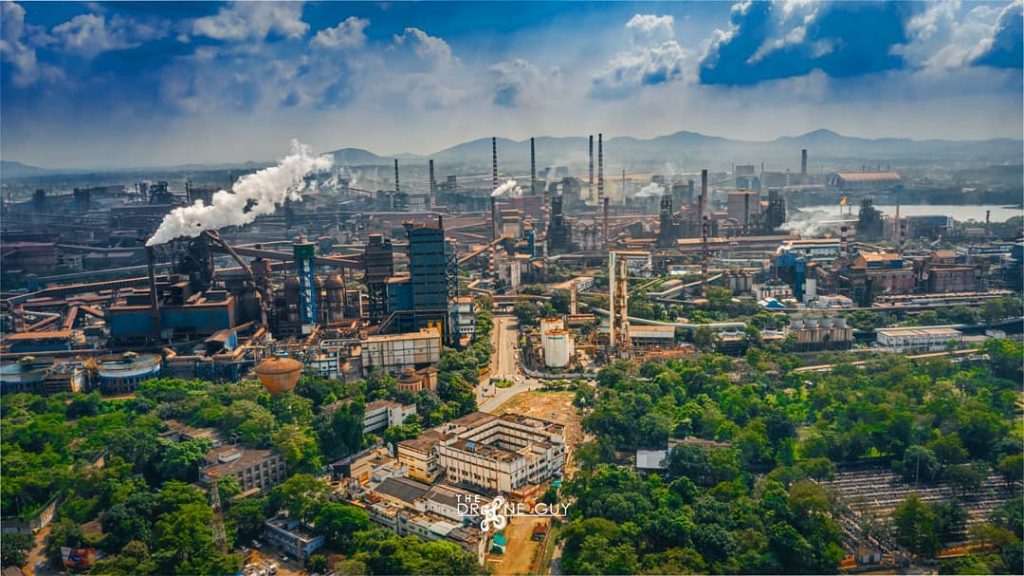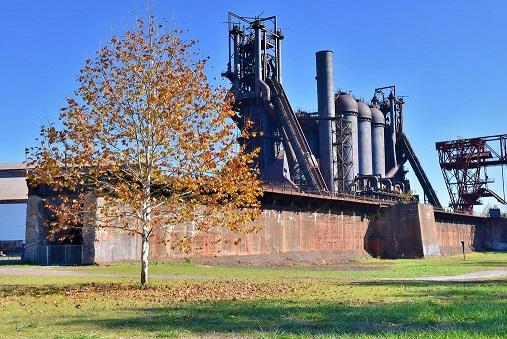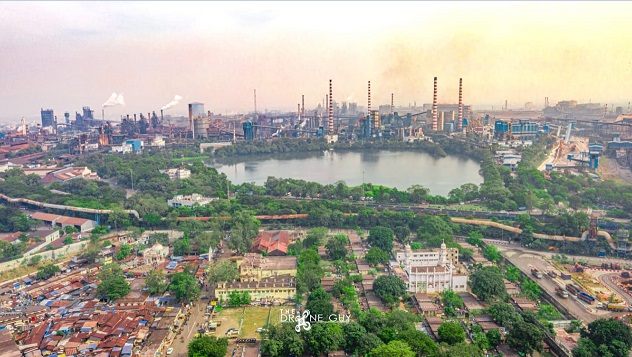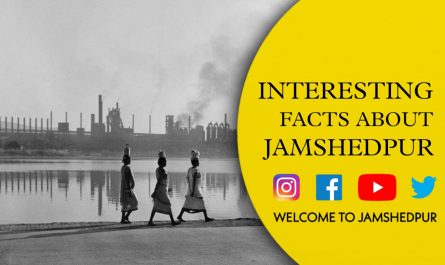Jamshedpur, located in the state of Jharkhand, is the first steel city of India, established by Sir Jamsetji N. Tata. The Tata Steel plant in Jamshedpur, set up in 1907, is the first integrated private steel plant in India.

Pittsburgh is the second-largest city in the state of Pennsylvania and the 20th largest metropolitan area in the United States. It is located in the southwestern part of the state at the confluence of the Allegheny and Monongahela rivers, which form the Ohio River. Pittsburgh is known as the ‘Steel City‘ for its more than 300 steel-related businesses and the ‘City of Bridges‘ for its 446 bridges.
Jamshedpur has been selected as the 84th fastest-growing city in the world by the City Mayors Foundation. It is also called the ‘Pittsburgh of India‘ because it shares all the similarities with the steel capital of the world.
- Both cities are rich in the availability of minerals and surrounding water resources.
- Sir Jamsetji N. Tata’s visit to Pittsburgh to learn advanced steel manufacturing techniques.
- An engineer from Pittsburgh, Julian Kennedy, was called to design the city of Jamshedpur.
What is Pittsburgh?
Pittsburgh is named after the British politician William Pitt. It is the second-largest city in the state of Pennsylvania and the 20th largest metropolitan area in the United States. Pittsburgh is located in the southwestern part of the state at the confluence of the Allegheny and Monongahela rivers, which form the Ohio River. Pittsburgh is known as the ‘Steel City‘ for its over 300 steel-related businesses and the ‘City of Bridges‘ for its 446 bridges.

Why and how did Pittsburgh become a steel town?
Pittsburgh was named in 1758 by General John Forbes in honor of the British politician William Pitt, the first Earl of Chatham. After the American Revolution, the development of the Pittsburgh village continued. One of its early industries was boatbuilding for settlers in the Ohio Country. The area had an abundant supply of all the essential mineral resources for iron-making, including iron ore, coal, manganese, and mica. Pittsburgh is located in the southwestern part of the state at the confluence of the Allegheny and Monongahela rivers, which form the Ohio River. This provided ample water supply for the production of iron and steel, which was another crucial factor.
By 1815, Pittsburgh was producing significant amounts of iron, brass, tin, and glass. The American Civil War boosted the city’s economy with the Union’s growing demand for iron and weapons. In 1875, Andrew Carnegie began steel production at the Edgar Thomson Steel Works in North Braddock, Pennsylvania, which later developed into the Carnegie Steel Company. He adopted the Bessemer process to increase production. Manufacturing was crucial for the development of Pittsburgh and its surrounding areas. Railroads were built along both rivers in the city, increasing transportation access to important markets.
By 1910, Pittsburgh was the 8th largest city in the country, accounting for one-third of the nation’s iron production and half of its steel production. As a result, the city quickly attracted the iron and steel industries and became the first steel city in the United States. Pittsburgh is known as the ‘Steel City‘ for its over 300 steel-related businesses.
How Jamsetji Tata Got An Idea To Establish The Steel Industry In India?
Jamshedji Tata was born on March 3, 1839, in the town of Navsari in southern Gujarat, to Nusservanji and Jeevanbai Tata. Jamshedji Nusserwanji Tata was an Indian pioneering industrialist who founded Tata Group, India’s largest conglomerate. He also established the city of Jamshedpur.
After graduating from Elphinstone College in Bombay in 1858, he joined his father’s export business. He had four main goals in his life: to establish an iron and steel company, create a world-class educational institution, build a unique hotel, and set up a hydroelectric power plant.
Once, when he was in Manchester, J.N. Tata attended a lecture by the philosopher Thomas Carlyle, in which Carlyle said, ‘He who controls iron will soon control gold.‘ Inspired by these words, J.N. Tata decided to establish India’s first steel plant.

Why is Jamshedpur called Pittsburgh of India?
Jamshedpur is called the ‘Pittsburgh of India‘ because it shares all the similarities with the steel capital of the world. Both cities are rich in minerals and have access to water resources. Another reason is that the city was designed by an engineer from Pittsburgh, Julian Kennedy.
When And Why Sir Jamsetji N Tata Went To Pittsburgh?
Jamshedji was eager to learn the latest techniques used in steelmaking at the time, so he went to Pittsburgh in the 19th century and brought back advanced technologies to India.
Why Jamsetji N Tata Chose Jamshedpur To Establish The Steel Industry?
Immediately after returning from Pittsburgh, he sought the help of geologist Charles Page Perrin to assist in finding an ideal location rich in iron, coal, limestone, and water. In 1904, Charles Perrin began the search in Madhya Pradesh, but he could not find a suitable location.
Later, the Maharaja of Mayurbhanj appointed a renowned geologist from his court, Pramath Nath Bose, to assist J.N. Tata. After extensive research, Bose discovered a small village called Sakchi (now known as Jamshedpur) and suggested to Sir J.N. Tata to establish the plant there.
What is Pittsburgh famous for?
By 1910, Pittsburgh was the 8th largest city in the country, accounting for one-third of the nation’s iron production and half of its steel production. As a result, the city quickly attracted the iron and steel industries and became the first steel city in the United States. Pittsburgh is known as the ‘Steel City‘ for its over 300 steel-related businesses and the ‘City of Bridges‘ for its 446 bridges.
Similarities Between Pittsburgh and Jamshedpur
| Basis | Pittsburgh | Jamshedpur |
| Minerals | Iron ore, coal, manganese, quartz, feldspar, mica, calcite, dolomite, and pyroxene. | Iron ore, coal, copper ore, mica, bauxite, fire clay, graphite, kainite, sillimanite, limestone, and uranium. |
| Water Sources | Allegheny, Monongahela, and Ohio. | Subarnarekha and Kharkai. |
| First Steel City | The first steel city in the United States and the steel-making capital of the world. | The first steel city in India. |
| Establishment | 1700s | 1900s |
| Named After | British statesman, William Pitt. | Indian pioneering industrialist, Sir Jamsetji Nusserwanji Tata. |
| Named By | General John Forbes. | British statesman, Lord Chelmsford. |
| Named In | 1758 | 1919 |
| First Steel Plant | 1875 | February 16, 1912. |
Frequently Asked Questions
Q) : Which country is Pittsburgh located?
Answer: Pittsburgh is located in the northeastern part of the United States.
Q) : Which city is called the Petersburg of India?
Answer: Jamshedpur is called the Pittsburgh of India.
Q) : Who named Jamshedpur?
Answer: In 1919, Lord Chelmsford named the city of Jamshedpur, which was originally Sakchi. It was named in honor of its founder, Sir Jamsetji Nusserwanji Tata.
Q) : Which is the Iron city of India?
Answer: Jamshedpur is known as the Iron City of India.
Q) : What is the old name of Jamshedpur?
Answer: The old name of Jamshedpur is Sakchi.
Q) : Are Jamshedpur and Tatanagar the Same?
Answer: Yes, Tata Nagar Junction is the name of the railway station in Jamshedpur city.
Q) : Jamshedpur is located in which state?
Answer: Jamshedpur is located in the state of Jharkhand.



